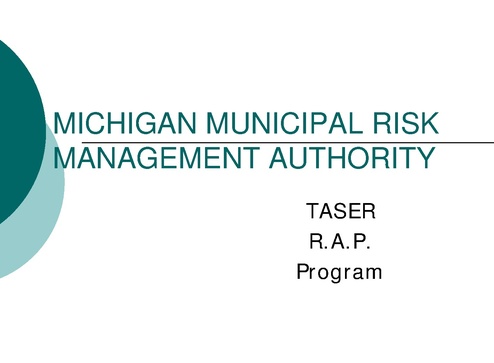Taser Mich Municipal Risk Management Authority
Download original document:

Document text

Document text
This text is machine-read, and may contain errors. Check the original document to verify accuracy.
MICHIGAN MUNICIPAL RISK MANAGEMENT AUTHORITY TASER R.A.P. Program MICHIGAN MUNICIPAL RISK MANAGEMENT AUTHORITY MMRMA is a public entity self-insurance pool which provides liability and property coverage. We provide local governments the opportunity to protect their organizations, their employees, their offices and their citizens from unexpected liability and property losses. In addition to our broad and high limits of liability and property coverage's, MMRMA provides risk management, claims administration, legal defense and reinsurance services to its members. OUR MEMBERS ARE…. • • • • • • • • • Villages, Townships, Cities and Counties Health-related facilities Municipal authorities Boards and commissions Library and library systems Courts Transportation authorities 911 Public Safety Communication systems Cable Communication systems LAW ENFORCEMENT DEMOGRAPHICS ¾ ¾ MMRMA represents 151 law enforcement agencies in Michigan Total of 6,346 officers are employed by those agencies TASERS IN MICHIGAN LEGISLATIVE HISTORY FOR TASER IN MICHIGAN January 2003 TASER use approved in Michigan for: ¾ ¾ ¾ ¾ ¾ ¾ ¾ Police officers State correction officers Licensed Private Investigatators Aircraft pilot or crew member Probation officer Court officer Bail agent LEGISLATIVE HISTORY (cont.) September 2004 statute amended ¾ Local correction officers added ¾ Michigan has a distinction between a “sworn peace officer” and a “corrections officer” RISK AVOIDANCE PROGRAM (RAP) z Projects which involve the potential for reduction in risk and liability exposure z May of 2003 the TASER RAP reimbursement project approved z Policy & Procedure for TASER developed for Public Safety and Correctional Officers 3 TASER RAP PROGRAMS ¾ Law enforcement reimbursement program ¾ Jail and lock-up program ¾ Court room program REQUIREMENTS OF TASER RAP PROGRAM z Each department to have a use of force protocol z Each officer to be trained in use of TASER z Protocol must include supervisory review of each use of TASER (we believe key to success in low # claims) z Copy of police report forwarded to MMRMA z Medical clearance on subjects (first 18 months) z Adopt our model policy/procedure TASER RAP PROGRAM z Train-the-trainer program around state z Included presentation at Ingham Regional Medical Center z July 2003, began partial reimbursement for TASERS z Since project inception MMRMA budgeted $200,000 z As of November 2005 expended in excess of $155,000 TASER REPORTING DATA 75 police/sheriff agencies taking part in program Represents 3,930 police officers 46 Departments have complied with our incident reporting requirement (61%) TASER USE DEFINITIONS Deployment – probes are discharged Drive stun – contact pain compliance Presentation – TASER presented to with laser and/or spark demonstration Failure – only included if both probes make contact DEFINITIONS (cont.) Injuries: Three types 1) 2) 3) ¾ Pre-TASER - occurred prior to TASER application TASER - Injury occurred due to TASER Secondary – occurred after TASER application Probe puncture was not classified as injury TASER DATA 582 TASER incidents consisting of: z 346 TASER deployments z 180 drive stuns z 31 Presentations z 25 Failures TASER USE DATA – cont. z9 Pre-TASER injuries z 41Seconday z1 injuries TASER related injury TASER USE DATA – cont. Of the 582 TASER incidents, ¾ 323 reported instances of substance abuse (55.4%). Of this: • 275 involved the use of alcohol (47.2%) • 48 instances of drugs/narcotics use (8.2%) ¾ 49 incidents were reported involving individuals needing psychiatric intervention (8.4%) REDUCTION IN EXCESSIVE FORCE CLAIMS 2004 1st full year of program 2000 2001 2002 2004 compared compared compared compared to to to to 2004 2004 2004 2003 51% reduction 2% reduction 37% reduction 37% reduction REDUCTION IN EXCESSIVE FORCE CLAIMS 2005 (through Nov. 30 2005) 2000 2001 2002 2003 2004 compared to 2005 compared to 2005 compared to 2005 compared to 2005 through 11/30/05 75% 63% 76% 76% 62% reduction reduction reduction reduction reduction RECENT RESERVES OR LITIGATION Of the 582 TASER incidents occurring over the last 28 months we have collected data: 5 incidents (less than 1%) have had reserves created: • • • • • 1 closed with $0 distribution 1 closed $31,600 distribution 1 remains open with a negligible reserve/criminal conviction 1 open pending litigation/OUIL/in-custody/drive-stun (new 1115-05) 1 open pending litigation/off duty PO/drive-stun FUTURE TRAINING CONSIDERATIONS Two or more TASER applications on single subject – documentation TASER application after handcuffed TASER application for controlling diabetic reaction Securing subject after first TASER application PROGRAM ACCOMPLISHMENTS ¾ Negligible number of claims in reserve ¾ Low number of excessive force complaints ¾ Absence of litigation MICHIGAN MUNICIPAL RISK MANAGEMENT AUTHORITY For additional information contact Mike Berthā Office – 734.245.7764 Cell – 734.216.9789 Email – mbertha@mmrma.org





